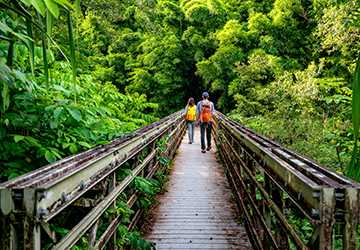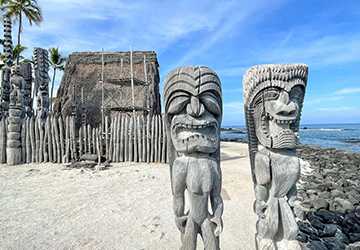7 Best National Parks in Hawaii for Tropical Escapes
Hawaii is a tropical island with many national parks and stunning geographical features. Due to the large number of parks, guests must select the most suitable parks to visit.
Hawaii is a tropical island with many national parks and stunning geographical features. Due to the large number of parks, guests must select the most suitable parks to visit.
The parks offer unique views and experiences, which can lead to regrets if missed. To avoid disappointment, take advantage of Hawaii's best experiences.

In this blog post, we'll explore Hawaii's top 7 national parks that promise to offer the best experience in the middle of beautiful terrains and different terrains.
Read on to find out which parks you should visit!
Why Visit Hawaii's National Parks?
Visiting the national parks in Hawaii is a must-do activity. These protected areas present the best natural territories of the state, including the tropical forests, the active volcanic cones, and the beaches.
Staying in such landscapes is an opportunity to free yourself from everyday pressures and get in touch with nature at its primal. Enjoying these parks is not just a ride on the culinary delight but also a learning experience.
You can learn about Hawaiian culture, plant and animal life, geology, and history through voluntary guided tours, interpretative signs, and programs. Outdoor activities such as hiking, snorkelling, watching wildlife, and many others suit the heart and soul.
When you enrol in supporting Hawaii's national parks, you also help support key conservation measures that will ensure the continued protection of these wonders.
7 Top National Parks for Tropical Escapes in Hawaii
Hawaii's national parks are treasures, providing visitors with incredible opportunities to explore the country's unique natural environment.
Here are seven parks that guarantee an unforgettable tropical getaway:
1. Hawai'i Volcanoes National Park
Witness the raw power of nature as you explore Hawai'i Volcanoes National Park, home to two active volcanoes: Kīlauea and Mauna Loa. The two central volcanoes in the Hawaiian Islands are Kīlauea and Mauna Loa.
This park also offers visitors an opportunity to get a close view of the lavas and understand the geographical formation of the Hawaiian Islands.
Visitors can hike through thick forests across savannah, rocky terrains, and desert-like areas and learn about the park's formation.
Take advantage of the opportunity to visit the Jaggar Museum. Here, you can acquire a lot of information about active volcanoes.
2. Haleakalā National Park
Wake up early for this tour and head to the Haleakalā summit before sunrise. Imagine waking up just in time to watch the sunrise, which changes the colours of the sky above the volcanic crater.
This park protects many ecosystems that contain diverse species of plants and animals. The Sliding Sands Trail is a scenic hike through the terrain with beautiful views of the environment.
3. Kalaupapa National Historical Park
Visit Kalaupapa National Historical Park, which offers an insight into the tragic past of the Kalaupapa Peninsula, a colony for leprosy patients.
This somewhat distant and picturesque park allows one to familiarize oneself with the region's history and enjoy the scenery.
The beaches are not crowded and are protected by high cliffs. A guided tour is recommended to understand the park better. The people of Kalaupapa have inspiring tales of hope and kindness you will never forget.
4. Pu'uhonua o Hōnaunau National Historical Park
Get a glimpse of early Hawaiians and their places of worship in Pu'uhonua o Hōnaunau National Historical Park. It was believed that this park was intended for those who violated the kapu and came to seek pardon.

It is a paradise for tourists because of the Hawaiian cultural experience that visitors are likely to encounter when strolling in the park, which contains several archaeological sites.
After exploring the land, it is advisable to swim in the clear waters of Hōnaunau Bay, where you can swim with sea anemones, corals, and tropical fish.
5. Kaloko-Honokōhau National Historical Park
Learn about the early Hawaiian people's tremendous engineering feats at the Kaloko-Honokōhau National Historical Park, which includes a beautiful fishpond and rock art or petroglyphs.
The native people of this park have managed to adopt sustainable fishing and aquaculture practices. Birdwatchers can enjoy several wetlands in the park, which host native and migratory birds.
After the cultural sites tour of the park, sun tan on the sandy white shoreline of Honokōhau Beach.
6. Hawaiian Islands Humpback Whale National Marine Sanctuary
Watch the majesty of humpback whales as they go to the warmer waters of the Hawaiian Islands in the winter. The Hawaiian Islands Humpback Whale National Marine Sanctuary is full of these magnificent animals, and many ways exist to see them.
First, it is recommended that one take a tour of the sanctuary's visitor centre to learn about the incredible underwater creatures and the initiatives being taken to save them.
Be sure to take a kayak or snorkel in the water. While doing so, you can see the whales coming up from the water.
7. Kīlauea Point National Wildlife Refuge
Learn about the unspoiled Kīlauea Point National Wildlife Refuge, a dwelling place for seabirds and native Hawaiian plants. It is a beautiful park with great views of the rocky shoreline and the ocean as far as the eye can see, and it houses the Kīlauea Lighthouse.
Take a stroll on the refuge trails, and carrying a pair of binoculars is advisable since you may see different types of seabirds. It is a perfect park for nature lovers because it aims to restore the natural habitat of the region's original flora and fauna.
Plan Your Hawaiian Adventure Today!
Keep these incredible national parks from getting off your bucket list. Begin dreaming of your Hawaiian vacation now so that you can get the best of the tropical escapes that the Hawaiian Islands have to offer.
You will imagine this when you walk through dense tropical forests, watch the working volcanoes, and swim in the clear sea. These are memories that you have yet to create; however, the ball is in your court.
Do not procrastinate—start your trip to Hawaii's national parks now and capture the moments that will make you smile in the future!
Frequently Asked Questions
Q. What is the best time to visit Hawaii's national parks?
Ans. The most favourable time to visit is between April and October, when the weather is most favourable. It is relatively warm but not overly hot during this time, and the probability of rainy days is low, so one can engage in outdoor activities and visit the parks.
Q. Are there entrance fees for these parks?
Ans. The entrance fees differ from one park to another. Some may be charged for, while others are offered for free. For the most up-to-date information, consult the official website of each park you plan to visit.
Q. Can I camp in these national parks?
Ans. Yes, there are camping facilities in many of the Hawaii national parks. Choices vary from primitive sites for tenting to campgrounds with amenities. Visit the park websites for details and to book a place.
Q. What should I pack for a visit to these parks?
Ans. They are water, sunscreen, good hiking shoes, and a camera. Expect different kinds of weather throughout the day and any outdoor activities. Visit park websites for more information about the activities you have in mind to do in the park.